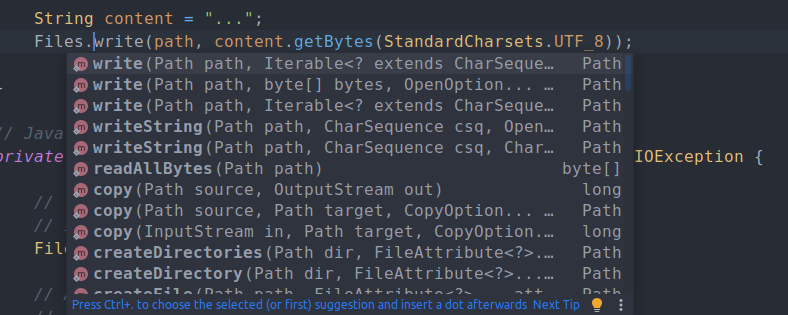Java create and write to a file

In Java, we can use Files.write to create and write to a file.
String content = "...";
Path path = Paths.get("/home/mkyong/test.txt");
// string -> bytes
Files.write(path, content.getBytes(StandardCharsets.UTF_8));
The Files.write also accepts an Iterable interface; it means this API can write a List to a file.
List<String> list = Arrays.asList("a", "b", "c");
Files.write(path, list);
Short History
Before Java 7, for writing bytes (image) to a file, we use FileOutputStream; for writing characters (text) to a file, we use FileWriter, and usually wrapped by a BufferedWriter to gain performance.
- In Java 7, there is a new NIO class named
java.nio.file.Files, and we can useFiles.write()to write both bytes and characters. - In Java 8, we can use
Files.newBufferedWriter(path)to create aBufferedWriter. - In Java 11, there is a new
Files.writeStringAPI to write string directly to a file.
1. Create and write to a file – Files.write
1.1 Before Java 7, we can use the classic FileWriter and BufferedWriter to write text to a file.
try (FileWriter fw = new FileWriter(file);
BufferedWriter bw = new BufferedWriter(fw)) {
bw.write(content);
bw.newLine();
}
In Java 7 and above, we can use one line Files.write to write a text to a file, and we also worry-free about closing the opened resource (file) because the Files.write will auto close the opened resource.
Files.write(path, content.getBytes(StandardCharsets.UTF_8));
1.2 The below example uses Files.write to create and write a String to a file.
package com.mkyong.io.file;
import java.io.*;
import java.nio.charset.StandardCharsets;
import java.nio.file.Files;
import java.nio.file.Path;
import java.nio.file.Paths;
import java.nio.file.StandardOpenOption;
import java.util.List;
public class FileWrite {
private static final String NEW_LINE = System.lineSeparator();
public static void main(String[] args) throws IOException {
Path path = Paths.get("/home/mkyong/test/aaa.txt");
writeFile(path, "Hello World 1" + NEW_LINE);
}
// Java 7
private static void writeFile(Path path, String content)
throws IOException {
// file does not exist, create and write it
// if the file exists, override the content
Files.write(path, content.getBytes(StandardCharsets.UTF_8));
// Append mode
// if the file exists, append string to the end of file.
// Files.write(path, content.getBytes(StandardCharsets.UTF_8),
// StandardOpenOption.CREATE, StandardOpenOption.APPEND);
// if file does not exist, throws NoSuchFileException
// if the file exists, append it
// Files.write(path, content.getBytes(StandardCharsets.UTF_8),
// StandardOpenOption.APPEND);
}
}
Output
Run the 1st time, and we created a file named aaa.txt.
Hello World 1
Run the 2nd time, we will override the file content.
Hello World 1
For append mode, we can define both StandardOpenOption.CREATE and StandardOpenOption.APPEND.
Files.write(path, content.getBytes(StandardCharsets.UTF_8),
StandardOpenOption.CREATE, StandardOpenOption.APPEND);
Run the 3rd time, this time with append mode enabled, we will append the new content to the end of the file.
Hello World 1
Hello World 1
1.3. The Files.write also support Iterable, it means we can pass a List to write multiple lines to a file.
List<String> list = Arrays.asList("a", "b", "c");
// Java 7
Files.write(path, list, StandardCharsets.UTF_8);
// Java 8, default utf_8
Files.write(path, list);
2. Java 11 – Files.writeString
In Java 7, we need to convert the String into a byte[] before passing it to Files.write.
String content = "...";
Files.write(path, content.getBytes(StandardCharsets.UTF_8));
In Java 11, we can use the new API named Files.writeString to write a String or text directly to a file.
// Java 11
private static void writeFileJava11(Path path, String content)
throws IOException {
// default utf_8
// file does not exists, create and write it
// if the file exists, override the content
Files.writeString(path, content);
// Append mode
// Files.writeString(path, content,
// StandardOpenOption.CREATE, StandardOpenOption.APPEND);
}
3. FileWriter + BufferedWriter
3.1 Before Java 7, the FileWriter + BufferedWriter combination is a standard solution for creating and writing characters or text to a file.
try (FileWriter fw = new FileWriter(file);
BufferedWriter bw = new BufferedWriter(fw)) {
bw.write(content);
bw.newLine(); // add new line, System.lineSeparator()
}
// append mode
try (FileWriter fw = new FileWriter(file, true);
BufferedWriter bw = new BufferedWriter(fw)) {
bw.write(content);
bw.newLine();
}
3.2 In Java 8, we can use the Files.newBufferedWriter to directly create a BufferedWriter object.
// default utf_8
try (BufferedWriter bw = Files.newBufferedWriter(path)) {
bw.write(content);
bw.newLine();
}
// append mode
try (BufferedWriter bw = Files.newBufferedWriter(path,
StandardOpenOption.CREATE, StandardOpenOption.APPEND)) {
bw.write(content);
bw.newLine();
}
P.S There is nothing wrong with the above FileWriter + BufferedWriter method to write a file, just the Files.write provides more clean and easy to use API.
4. FileOutputStream
In Java, we use FileOutputStream to write raw bytes to a file, like an image.
private static void writeFile(File file, byte[] bytes) throws IOException {
try (FileOutputStream fos = new FileOutputStream(file)) {
fos.write(bytes);
}
// append mode
/*try (FileOutputStream fos = new FileOutputStream(file, true)) {
fos.write(content.getBytes(StandardCharsets.UTF_8));
}*/
}
Download Source Code
$ git clone https://github.com/mkyong/core-java
$ cd java-io
very excellent tutorial
Before writing file, is it possible to check the file write,read permission and also do you code reference where we can check for disk space before writing ?